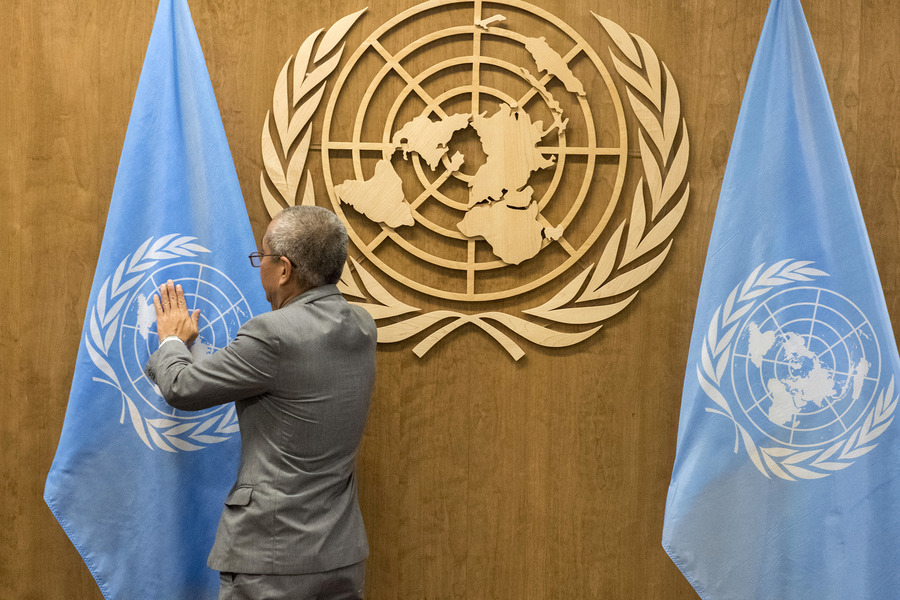The Limits of America Alone

Published by The Lawfare Institute
in Cooperation With

Editor’s Note: The Trump administration has advocated reducing U.S. economic interdependence and prioritizing efforts to balance against China; this, officials argue, will increase U.S. resilience. But Jacob Sharpe, a former project lead at the Defense Innovation Board, and Sam Denney, of the Atlantic Council, note that the United States can better balance China, both militarily and economically, with the help of its European allies. They suggest that the complementary advantages of the U.S. and European economies can bolster the allies’ defense-industrial base, making them more prepared to deter or respond to a crisis.
Dana Stuster
***
President Trump’s unilateralist foreign policy risks permanently alienating the United States from its closest allies in Europe and, ultimately, reducing U.S. national power in its rivalry with China. Twenty-first century competitiveness requires that the United States stop thinking of its European allies as dependents and reconceptualize them as co-producers of power.
Over the past 10 months, Washington has attempted to reset the global trading order and refocus U.S. defense-industrial bandwidth on the Indo-Pacific to deter China. As a result, America’s European allies are dealing with an unsatisfactory and unpredictable trade relationship, volatile support for Ukraine, waning defense-industrial cooperation, and increasing exposure to diverted Chinese exports. More broadly, the Trump administration’s imposition of global tariffs by executive order has violated all U.S. commitments made in free trade agreements and destroyed every country’s trust in the United States. Resource limitations and diminished relative strength, some U.S. policymakers argue, require that the United States make an aggressive shift to the Indo-Pacific and spurn longtime allies. This logic, however, fails to grasp both the breadth of the contest for the 21st century and the critical nodes of U.S. power.
A smarter approach would treat America’s European allies as co-producers of power, retooling U.S. defense-industrial capacity and strengthening its geoeconomic toolkit to compete with China. This would result in pooled capacity characterized by industrial interdependence, shared military might, free-moving innovation, and contributions aligned with each nation’s competitive advantages. The Trump administration’s current path will all but guarantee a United States that is weakened and alone.
Defense-Industrial Might
The Trump administration’s driving claim is that European allies and partners inhibit the United States’s ability to deter and win a war in the Indo-Pacific. Every munition sent to Europe is, in this view, a munition not available in the Indo-Pacific and a misallocation of finite manufacturing capacity. The defense-industrial base, they argue, serves a bygone age of U.S. primacy and overly emphasizes the needs of allies and partners. This is presented as a measured approach to the distribution of increasingly limited resources, but rests on a misunderstanding of modern defense markets. While recent Pentagon initiatives have begun to recognize this error, U.S. industry partners continue to feel the consequences of the Department of Defense’s attitude toward European partners, and department leadership still fails to grasp the importance of Europe to American power. Europe has a critical role to play both as a passive consumer of U.S. defense products and as an active contributor to defense-industrial revival.
Since the late 19th century, industrial capacity has undergirded U.S. power. Indeed, during World War II, the United States produced nearly two-thirds of the equipment used by the Allies. While the economic preponderance that the United States enjoyed in 1945 was an anomaly, this economic and industrial dynamism was essential to its success in the Cold War and allowed it to simply outproduce the stagnating Soviet Union.
Today, the United States faces a different economic and industrial reality. While U.S. gross domestic product (GDP) is approximately 26 percent of the world’s total, the nation’s manufacturing capacity has shrunk. The U.S. currently accounts for 16.3 percent of global manufacturing while China sits at 30.9 percent. It ranks 10th in the world in robot adoption density. Its crude steel production is less than 5 percent of global total output. It accounts for only about 0.1 percent of global shipbuilding. The situation is clear: The United States is ceding the ability to produce physical things.
This gap is especially acute in the defense-industrial space. While the United States still leads in the research and development of defense items, it lacks the capacity to fight the way it wants to fight over long time frames. U.S. strikes against the Houthis highlighted this deficiency, as rapidly depleting weapons stockpiles panicked war planners tasked primarily with deterring China from crossing the Taiwan Strait. Were the United States to enter a conflict with a peer or near-peer competitor, it would run frighteningly low on critical munitions in a matter of days or weeks and have no means to replenish stocks on any reasonable time frame.
Fortunately, the United States is not alone in this realization. Throughout Europe, policymakers are realizing that the strategic environment has shifted rapidly, and the defense posture of the past is no longer fit for purpose. At the most recent NATO Summit, the alliance committed itself to investing 5 percent of GDP toward core defense spending and defense-related critical infrastructure. This is a prime opportunity for Americans and Europeans to reorient their defense relationship and update it for modern times. Enhanced integration with European allies is an essential step to overcome significant industrial disadvantages and to present a unified front with the scale needed to deter and win conflicts. There are three key areas of collaboration that should be pursued to reinvigorate the industrial base: supply, capacity, and demand.
First, the United States must address supply shortages and bottlenecks occurring from rare earth elements (REEs). Currently, China produces 90 percent of rare-earth high-performance magnets and refines 85 percent of the world’s REEs, many of which are critical for defense systems. The modern world runs on these minerals, and uncertainty surrounding their availability seriously threatens a wide array of critical production lines.
Despite significant capital expenditure requirements and environmental concerns, the EU launched the EURARE and ASTER projects, which are intended to survey rare earth deposits in Europe and understand potential extraction. More recently, the EU’s Critical Raw Minerals Act has begun work to ensure access to essential REEs through streamlined permitting, domestic capacity benchmarks, enhanced critical mineral recycling, and more. Building on this momentum, the 1.5 percent of GDP that NATO states are meant to invest in “defense-related critical infrastructure” could play a significant role in realizing REE initiatives. Further, these REE projects should be the product of comprehensive extraction and refinement partnerships across the transatlantic community, creating a wide ecosystem capable of sustaining critical technology production. To establish confidence in this shift, the United States and its allies can coordinate agreements requiring the integration of domestic or allied REEs in defense products, further buttressing these supply chains against disruption and signaling real change to industry partners.
Second, to ensure sufficient production capacity to match adversarial states, the United States should also pursue expanded research, development, and production agreements with European partners. Be it U.S.-Japanese co-development and co-production of SM-3 Block IIA missile interceptors, German production of PAC-3 MSE interceptors, or long-delayed plans for Javelin production in Poland, there is a wide array of possibilities to remedy insufficient capacity from U.S. defense firms. It is critical that the United States leverage European factories and skilled laborers to reconstitute a viable industrial base. More interconnected industrial engagements will expand the supply of critical munitions, offset the costs of research and development, mitigate the effect of supply chain disruptions, expand foreign direct investment in the United States, and assuage European fears about dependence on U.S. defense technology.
Third, Europe can serve as a key engine of demand for defense products. Europe needs things that the United States produces, and the United States needs a larger and steadier defense market. The Defense Department and private defense firms are struggling to plan and invest amid ongoing budget volatility and continuing resolutions. The department itself acknowledges that it has “been unable to effectively manage the constraints of continuing resolutions on acquisition programs.” More broadly, Defense Department components recognize how integral foreign markets are for their acquisition plans. The Army’s own budget documents stated that “[u]nit prices reflect an assessed yearly Foreign Military Sales (FMS) procurement of PAC-3 missile variants. In the event that FMS procurements do not occur at this level, the budgeted missile unit price may not be achievable.” Larger and more predictable orders would justify private-sector investment in production lines and drive down unit costs. Money, unsurprisingly, is the simplest answer to many U.S. defense-industrial woes. But these investments won’t happen without Europe.
Recent efforts to replenish Terminal High Altitude Area Defense (THAAD) anti-ballistic missile interceptors illustrate these issues. While public estimates vary, the United States spent 14-25 percent of its total THAAD interceptor inventory to intercept Iranian strikes against Israel. At current production rates, it could take as many as eight years to replenish those stockpiles. This is often characterized as an industry failure but is more accurately insufficient demand signals. The Defense Department ordered 11 THAAD interceptors in 2023, 12 in 2024, and 25 in 2026, with the option for an additional 12. When annual orders hover in the low double digits, per-unit prices stay high and new manufacturing investment is impossible to justify. Acquisition officials, meanwhile, must prioritize keeping production lines alive. There is limited money for larger orders or industrial investment and scant congressional concern for long-term acquisition planning.
European engagement helps bridge this gap. The United States can provide access to cutting-edge military technologies, while European rearmament efforts enable the scale necessary to grow the defense-industrial base. With larger bulk orders, cost per unit would decrease and more stable funding lines would be clear to various companies engaged in the market. This will allow the United States to get more of what it needs while bolstering its ability to further ramp up production as necessary.
Many of the issues facing the defense-industrial base are dire, and the United States cannot fix them alone. The Trump administration’s decision to limit sales to European allies will not only fail at its intended purpose but also exacerbate already critical issues and undermine the trust needed to pursue a deeper defense-industrial partnership. Targeted intervention and the integration of European allies and partners can help alleviate these concerns in the short term, and fundamentally reorient the defense-industrial base in the long term.
Geoeconomic Interdependence
More broadly, the Trump administration’s economic worldview rests on the idea that other countries, America’s closest allies included, have deliberately taken advantage of the U.S. economy and, by extension, the American worker. Under this zero-sum logic, the only remedy then is to take aggressive and unilateral action to reset and renegotiate the terms of trade with the rest of the world.
America’s European allies are an essential part of an effective geoeconomic strategy for the 21st century. U.S.-China competition today is taking place in an economic environment that is more deeply integrated than at any other point in history. This mixture of increasing geopolitical competition and deep interconnectedness has also created a profound degree of uncertainty and complexity that challenges the principles of openness upon which the current international system is built and harkens back to the early 1900s.
Despite its leading position, the United States cannot wage this economic competition alone. The historical record from World War I and the interwar period provides clear lessons why a fragmented or unilateral approach to economic competition in an environment marked by multipolarity and intense competition is short-sighted. Initial British efforts to unilaterally blockade Germany by brute force during World War I led to a crisis in relations with the United States, which relied on trade with Europe and at times undermined British efforts. Likewise, League of Nations efforts to deploy sanctions in response to fascist Italy’s invasion of Ethiopia in 1935 failed because the United States remained neutral and even saw its oil exports to Italy rise during the war. Successfully deploying coercive economic power requires a little help from one’s allies, even for major powers at the heart of the global economy.
Today, the United States will need the combined strength of its key allies in Europe whether it wants to promote greater economic security within the international trading system or deter (or effectively punish) a potential Chinese invasion of Taiwan. Particularly in an environment where it finds itself in a competition with a near-peer adversary, the United States cannot afford to make the mistakes of the past. Instead, the United States should seek to build a greater and more durable alignment with its European allies to defend their shared economic advantages from Chinese overcapacity and state capitalism.
To pursue an allied economic security strategy, the United States and its allies would negotiate a series of bilateral or multilateral economic security agreements that facilitate greater cooperation and more effective coordination against China. Premising these economic security agreements on deeper economic integration would allow the United States and Europe to more effectively mitigate the effects of greater decoupling from China by opening up new markets for goods while maintaining environmental protection and high labor standards. What would begin as a smaller pact between the United States and its key allies could also serve as the foundation for a broader economic security arrangement that exchanges commitments to reduce risks posed by an overreliance on Chinese supply chains and improve environmental and labor standards with reductions in tariffs and non-tariff barriers.
Likewise, the United States and its key allies in Europe and beyond possess a preponderance of economic power over China. Companies headquartered in either the United States or U.S. allies generate a total of 73 percent of global profits (38 percent by U.S. firms and 35 percent by allied firms) compared to 16 percent by Chinese firms. And while China may lead in manufacturing, this manufacturing dominance is based on technology and designs from U.S. and allied firms. This economic power creates significant leverage over China that could be deployed with great effect in response to a Chinese attempt to change the status quo in Taiwan by force, so long as the United States and its allies act together in response to a crisis. A broad economic decoupling or blockade by the United States and its allies would disrupt nearly 40 percent of Chinese GDP, compared to just under 4 percent of U.S. GDP. Over the long term, U.S. and allied GDP would eventually return to pre-decoupling baselines, while China’s GDP would suffer permanently. However, this strategy would work only if the United States works together with its allies. Were the United States to attempt to unilaterally decouple itself from China, China would see only a 4-7 percent disruption in GDP and the United States a 4-5 percent disruption, all the while causing two to seven times as much disruption to key allies.
Such a shift from Washington toward deeper integration with its allies could not come at a better time because the European Union’s approach to competition with China appears to be sputtering. While the European Union has sanctioned mainland Chinese companies that provide Russia with military technology and targeted Chinese dual-use companies, its derisking strategy has been inconsequential thus far and the bloc is now more dependent on trade with China than it was when it launched its derisking strategy in 2023. The European Union is reportedly in the process of rethinking its China strategy and will roll out new China-focused economic measures by the end of 2025. U.S. officials are also reportedly beginning to come around on the necessity of cooperating with Europe on rare earths after Chinese export controls revealed America’s vulnerabilities, creating an opportunity for transatlantic engagement on a shared approach to geoeconomic competition with China. After all, the United States can ill afford to ignore 21 percent of the global economy as it faces down a near-peer economic competitor.
Instead, President Trump’s scattershot global tariff campaign has effectively made any deep economic relationship with the United States a risk. And while Europe was able to strike a trade deal with the Trump administration that avoids a transatlantic trade war, it is still stuck with the new reality of dependence on an unpredictable United States. This development is likely to only increase the continent’s desire for greater independence from the United States and increase the threat that the continent faces from China.
The Limits of America Alone
“America Alone” is an appealing yet dangerous temptation. In an era marked by political cynicism and the fear of a rising China overtaking a “decadent” United States, a narrow realism that seeks to focus U.S. strategy on what are perceived to be its immediate strategic interests is tantalizing. It matches the pessimism of the current moment. A re-envisioning of U.S. foreign policy is indeed deeply necessary to enhance U.S. competitiveness, but the solutions provided by the Trump administration’s vision of America Alone will lead the United States down the wrong path. Abandoning Europe will diminish U.S. power and continue a long and slow march toward weakness in the Indo-Pacific and in the wider contest for the future of the international order.
Washington is confronting a near-peer adversary in a geopolitical environment that exhibits more complexity and interconnection than at any other time in human history. Prioritizing short-term advantages in trade and military deployments comes at the cost of long-term competitiveness and alliances built up over decades. By pursuing short-term advantage, the United States will ensure that its allies are less willing to coordinate on economic and industrial measures, and increasingly likely to pursue trade relationships that exclude it.
An effective U.S. strategy to compete with China will require that the United States view its system of alliances as an essential tool to project power at scale rather than as a source of U.S. overextension. Such an approach would build on the post-1945 tradition of U.S. foreign policy informed by the searing lesson from the Great Depression and World War II that prosperity and security are indivisible. It also would take a page from the successful strategy employed by President Reagan to end the Cold War, one that wielded the “multidimensional nature of American power” to combine the unlimited potential of the U.S. economy, the support of U.S. allies, and an approach to the Soviet Union that mixed reassurance, persuasion, and pressure.
To effectively compete in the 21st century, the United States must broaden its base of power, more effectively integrate allied and partner capabilities, and develop a cohesive bloc capable of outcompeting any adversarial state. That will not happen without Europe.






